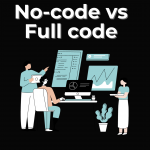Low and no-code tools have the potential to significantly disrupt tech development, and they are already making substantial strides in this direction. These platforms empower individuals with limited coding experience to create complex applications and automate processes, reducing the traditional coding barriers to entry in software development. One of the most significant impacts of low and no-code tools is democratizing tech development. They enable a broader range of people, including business analysts, designers, and non-technical professionals, to participate in building software solutions. This democratization fosters innovation, accelerates project delivery, and reduces the reliance on specialized development teams.
Furthermore, low and no-code tools streamline development processes by providing pre-built components and templates, allowing developers to focus on higher-level problem-solving rather than writing code from scratch. This efficiency can lead to faster development cycles and reduced costs. However, while these tools offer immense potential, they may not entirely replace traditional coding. Complex, highly customized applications and projects often require custom code for optimal performance and functionality. Additionally, security and scalability concerns must be carefully managed when using low and no-code solutions.
What are the practical applications and benefits of no-code development tools?
No-code refers to a category of software development tools and platforms that allow individuals to create applications and software solutions without having to write traditional code or programming languages. These platforms use visual interfaces, drag-and-drop functionality, and pre-built components to enable users with little to no coding experience to design and develop software applications.
Rapid Application Development
No-code platforms are synonymous with speed. They empower users to create applications at a fraction of the time it would traditionally take a lot of time using traditional coding. For businesses, this means the ability to swiftly respond to market shifts and emerging opportunities. Whether it’s building a new customer-facing app or an internal workflow solution, the agility offered by no-code development can be a game-changer.
Empowering Non-Developers
One of the most compelling aspects of no-code is its ability to bridge the gap between technical and non-technical team members. Business analysts, marketing professionals, and domain experts can now actively contribute to software development. This reduces the burden on IT departments, accelerates project delivery, and ensures that software aligns more closely with business needs.
Prototype and MVP Development
For startups and entrepreneurs, building a prototype or Minimum Viable Product (MVP) is a crucial step in validating ideas and securing funding. No-code platforms provide an ideal environment for this purpose. They allow innovators to translate concepts into functional applications rapidly. By testing these prototypes in the real world, creators can gather valuable user feedback and iterate before investing heavily in full-scale development..
Automating Workflows
No-code tools excel at automating repetitive tasks and workflows. This can lead to significant improvements in operational efficiency and accuracy. For instance, in healthcare, no-code solutions can automate patient record updates, while in finance, they can streamline invoice processing. Reduced manual intervention not only saves time but also reduces the risk of human error.
Cost-Effective Solutions
Cost-effectiveness is a hallmark of no-code development. By eliminating or reducing the need for expensive software developers, organizations can significantly lower their development and maintenance costs. This democratizes software creation, making it accessible to smaller businesses and startups with limited budgets.
Innovation
Innovation thrives in environments that encourage experimentation. No-code platforms provide a safe space for creative problem-solving. Users can rapidly bring their ideas to life, test them, and refine them based on feedback. This iterative approach fuels innovation, helping organizations stay competitive and responsive to changing market dynamics.
Data Integration
No-code tools simplify the integration of data from various sources, APIs, and third-party services. This makes it easier to work with data and create data-driven applications. Businesses can leverage data more effectively for analytics, reporting, and decision-making, ultimately driving better outcomes.
Scaling Capabilities
Some advanced no-code platforms offer scalability, enabling applications to grow alongside expanding business needs. This is particularly valuable for startups and growing companies that can start with small-scale solutions and adapt them as their user base and requirements expand.
Exploring the Impacts of Low-Code and No-Code Development on Front-End Tech
The emergence of low-code and no-code tools has not only transformed the tech development landscape but also revolutionized the field of front-end development and traditional coding. These innovative platforms empower a broader range of individuals, from non-developers to seasoned programmers, to create captivating and responsive user interfaces without extensive manual coding. Understanding their impact on front-end development sheds light on the broader question of whether low-code and no-code tools will disrupt tech development.
Rapid Front-End Prototyping:
Front-end development often begins with the creation of prototypes and mockups. Low-code front-end tools streamline this process by providing visual interfaces for designing user interfaces. Designers and non-technical stakeholders can create interactive prototypes quickly, facilitating better communication and feedback.Visual Interface Design:
Low-code front-end tools allow designers to visually design user interfaces. They offer a range of pre-built components and templates, making it easier to craft responsive and visually appealing layouts without delving into complex CSS or HTML coding.User Experience Enhancement:
Front-end development’s primary goal is to provide an exceptional user experience. Low-code and no-code platforms emphasize user-friendly design by enabling designers and developers to focus on usability, accessibility, and responsiveness.Cross-Platform Compatibility:
Front-end development often involves addressing the challenges of cross-platform compatibility. Low-code front-end solutions assist in creating responsive designs that adapt seamlessly to various devices and screen sizes, improving user satisfaction.Integration and Automation:
Front-end development is closely tied to data integration and automation. Low-code tools offer integration capabilities with databases, APIs, and third-party services, simplifying data-driven front-end applications and workflow automation.Collaboration and Interdisciplinary Teams:
Low-code and no-code tools facilitate collaboration between front-end developers, designers, and non-technical team members without the need for traditional coding. This interdisciplinary approach results in cohesive and user-centric interfaces.Cost-Effective Front-End Solutions:
Developing intricate front-end interfaces traditionally involves significant time and resources. Low-code front-end development reduces development time, making it cost-effective and accessible to a broader range of businesses and organizations.Front-End Scalability:
As businesses grow, so do their front-end development needs. Low-code front-end solutions can scale to accommodate increasing user interactions and evolving requirements, ensuring a seamless user experience as businesses expand.
Can no-code Replace Developers?
In recent years, the tech industry has witnessed a surge in low-code and no-code development platforms,des These tools promise to democratize software development by enabling individuals with limited coding experience to create applications. While they undoubtedly offer numerous benefits, a looming question remains: can low-code and no-code truly replace developers, especially in the realm of front-end development?
The Rise of Low-Code and No-Code:
Low-code and no-code platforms have gained popularity due to their user-friendly interfaces and the ability to speed up application development. They allow users to design interfaces, workflows, and even complex logic without writing extensive code. For front-end developers, this raises concerns about the future of their roles.The Role of Front-End Developers:
Front-end developers are responsible for crafting user experiences, and ensuring web applications are visually appealing, responsive, and accessible. They possess a deep understanding of HTML, CSS, JavaScript, and various frameworks. However, the advent of low-code and no-code tools doesn’t necessarily render them obsolete.Enhancing Developer Productivity:
Rather than replacing front-end developers, these tools can augment their capabilities. Developers can use low-code platforms to prototype ideas quickly, collaborate with non-technical team members, and automate repetitive tasks as well as add to the impact of traditional coding. This empowers them to focus on more complex and innovative aspects of front-end development.Limitations of Low-Code and No-Code:
While these tools are excellent for certain use cases, they may fall short in complex projects that demand custom solutions. Front-end development often requires fine-tuning user interfaces, optimizing performance, and ensuring cross-browser compatibility, tasks that may still require skilled developers.The Future of Front-End Development and Traditional Coding:
The integration of low-code and no-code into front-end development and traditional coding workflows is undeniable. Front-end developers can leverage these tools to accelerate project delivery, but their expertise remains invaluable for crafting exceptional user experiences and solving intricate technical challenges.
In conclusion, low-code and no-code development tools are powerful allies for front-end developers, streamlining tasks and opening opportunities for collaboration. However, they are unlikely to replace developers entirely. Instead, they are poised to reshape the landscape of front-end tech, making development more accessible and efficient while emphasizing the continued importance of skilled front-end developers.
The need for software developers and Traditional Coding continues to be significant.
Despite the proliferation of no-code and low-code development platforms, the demand for software developers remains robust in the tech industry. These platforms offer significant advantages in terms of speed and accessibility, but they do not pose a threat to the role of software developers. Instead, they complement it by addressing specific use cases and requirements.
No-code and low-code platforms excel in scenarios where rapid development and prototyping are essential. They empower non-technical individuals to create simple applications and automate routine tasks, reducing the burden on IT departments. This democratization of development can streamline business operations, foster innovation, and accelerate time-to-market for many projects, hence traditional coding is important.
Explore GeekyAnts: Your One-Stop Hub for Exceptional Developers!
However, their limitations become apparent when dealing with complex, highly customized, or mission-critical applications. Software developers bring a depth of expertise and problem-solving skills to the table that automated platforms cannot replicate. They design scalable, efficient, and secure solutions tailored to specific business needs, ensuring optimal performance and data protection.
Moreover, software developers remain at the forefront of technological innovation, continuously exploring new programming languages, frameworks, and tools to create cutting-edge solutions. They are adaptable professionals who can tackle emerging challenges and leverage the latest advancements in technology.
In essence, while no-code and low-code platforms enhance accessibility and accelerate certain aspects of development, they are unlikely to replace software developers entirely. Instead, these platforms augment the capabilities of developers, allowing them to focus on more intricate, high-value tasks, ensuring their continued significance in the ever-evolving tech landscape.




















